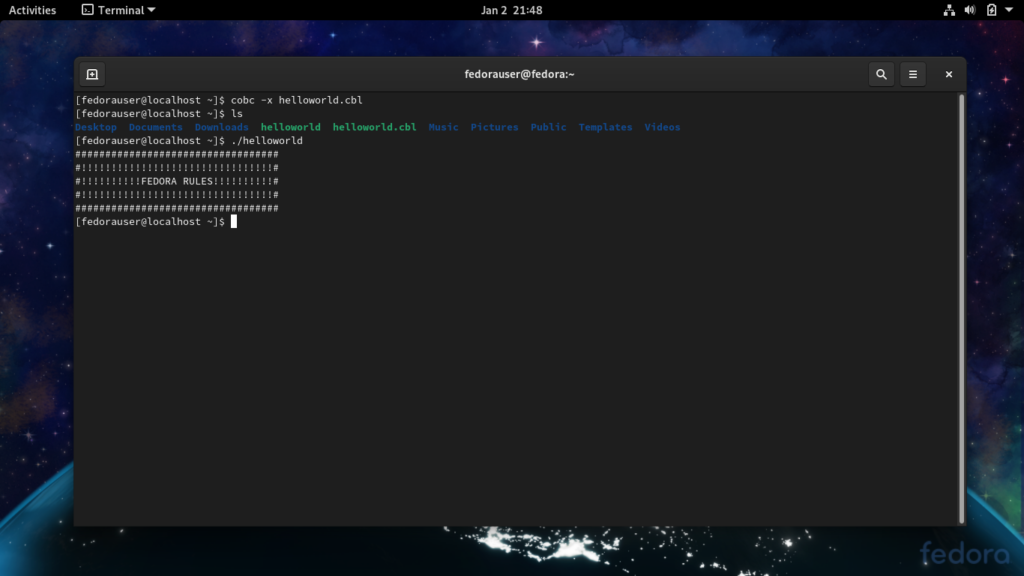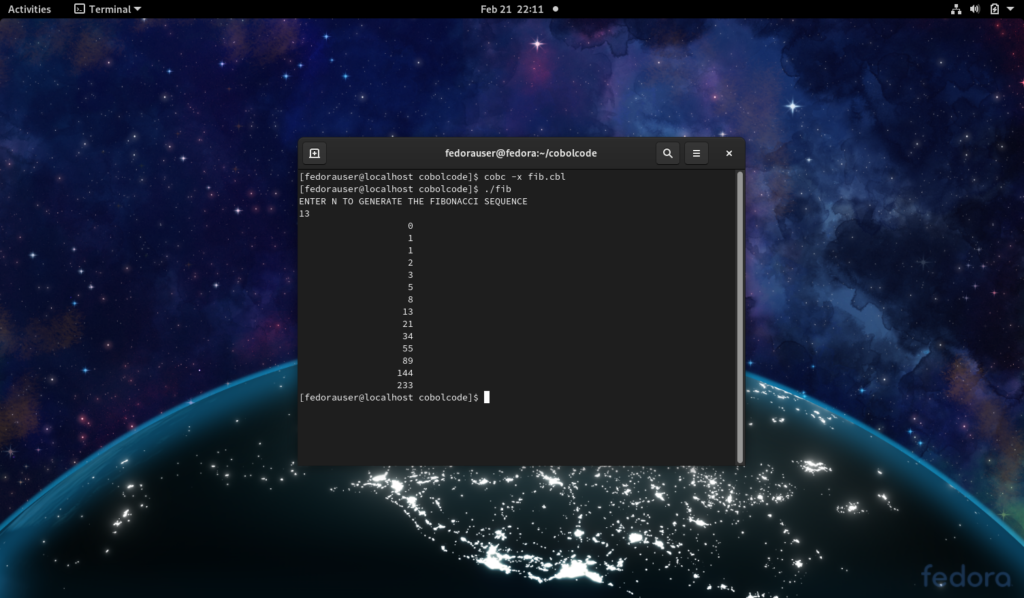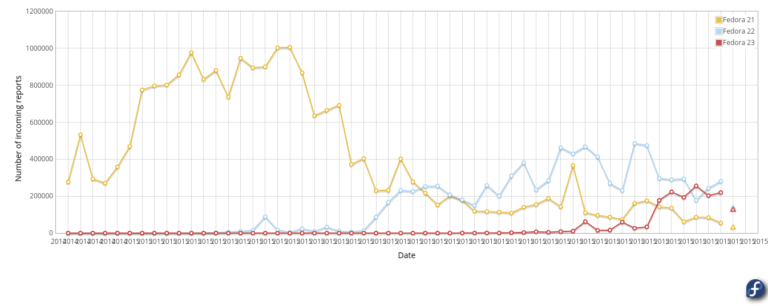Though its popularity has waned, COBOL is still powering business critical operations within many major organizations. As the need to update, upgrade and troubleshoot these applications grows, so may the demand for anyone with COBOL development knowledge.
Fedora 33 represents an excellent platform for COBOL development.
This article will detail how to install and configure tools, as well as compile and run a COBOL program.
Installing and configuring tools
GnuCOBOL is a free and open modern compiler maintained by volunteer developers. To install, open a terminal and execute the following command:
# sudo dnf -y install gnucobol
Once completed, execute this command to verify that GnuCOBOL is ready for work:
# cobc -v
You should see version information and build dates. Don’t worry if you see the error “no input files”. We will create a COBOL program file with the Vim text editor in the following steps.
Fedora ships with a minimal version of Vim, but it would be nice to have some of the extra features that the full version can offer (such as COBOL syntax highlighting). Run the command below to install Vim-enhanced, which will overwrite Vim-minimal:
# sudo dnf -y install vim-enhanced
Writing, Compiling, and Executing COBOL programs
At this point, you are ready to write a COBOL program. For this example, I am set up with username fedorauser and I will create a folder under my home directory to store my COBOL programs. I called mine cobolcode.
# mkdir /home/fedorauser/cobolcode # cd /home/fedorauser/cobolcode
Now we can create and open a new file to enter our COBOL source program. I’ll call it helloworld.cbl.
# vim helloworld.cbl
You should now have the blank file open in Vim, ready to edit. This will be a simple program that does nothing except print out a message to our terminal.
Enable “insert” mode in vim by pressing the “i” key, and key in the text below. Vim will assist with placement of your code sections. This can be very helpful since every character space in a COBOL file has a purpose (it’s a digital representation of the physical cards that developers would complete and feed into the computer).
IDENTIFICATION DIVISION. PROGRAM-ID. HELLO-WORLD. *simple helloworld program. PROCEDURE DIVISION. DISPLAY '##################################'. DISPLAY '#!!!!!!!!!!!!!!!!!!!!!!!!!!!!!!!!#'. DISPLAY '#!!!!!!!!!!FEDORA RULES!!!!!!!!!!#'. DISPLAY '#!!!!!!!!!!!!!!!!!!!!!!!!!!!!!!!!#'. DISPLAY '##################################'. STOP RUN.
You can now press the “ESC” key to exit insert mode, and key in “:x” to save and close the file.
Compile the program by keying in the following:
# cobc -x helloworld.cbl
It should complete quickly with return status: 0. Key in “ls” to view the contents of your current directory. You should see your original helloworld.cbl file, as well as a new file simply named helloworld.
Execute the COBOL program.
# ./helloworld
If you see your text output without errors, then you have sucessfully compiled and executed the program!

Now that we have the basics of writing, compiling, and running a COBOL program, lets try one that does something a little more interesting.
The following program will generate the Fibonacci sequence given your input. Use Vim to create a file called fib.cbl and input the text below:
****************************************************************** * Author: Bryan Flood * Date: 25/10/2018 * Purpose: Compute Fibonacci Numbers * Tectonics: cobc ****************************************************************** IDENTIFICATION DIVISION. PROGRAM-ID. FIB. DATA DIVISION. FILE SECTION. WORKING-STORAGE SECTION. 01 N0 BINARY-C-LONG VALUE 0. 01 N1 BINARY-C-LONG VALUE 1. 01 SWAP BINARY-C-LONG VALUE 1. 01 RESULT PIC Z(20)9. 01 I BINARY-C-LONG VALUE 0. 01 I-MAX BINARY-C-LONG VALUE 0. 01 LARGEST-N BINARY-C-LONG VALUE 92. PROCEDURE DIVISION. *> THIS IS WHERE THE LABELS GET CALLED PERFORM MAIN PERFORM ENDFIB GOBACK. *> THIS ACCEPTS INPUT AND DETERMINES THE OUTPUT USING A EVAL STMT MAIN. DISPLAY "ENTER N TO GENERATE THE FIBONACCI SEQUENCE" ACCEPT I-MAX. EVALUATE TRUE WHEN I-MAX > LARGEST-N PERFORM INVALIDN WHEN I-MAX > 2 PERFORM CASEGREATERTHAN2 WHEN I-MAX = 2 PERFORM CASE2 WHEN I-MAX = 1 PERFORM CASE1 WHEN I-MAX = 0 PERFORM CASE0 WHEN OTHER PERFORM INVALIDN END-EVALUATE. STOP RUN. *> THE CASE FOR WHEN N = 0 CASE0. MOVE N0 TO RESULT. DISPLAY RESULT. *> THE CASE FOR WHEN N = 1 CASE1. PERFORM CASE0 MOVE N1 TO RESULT. DISPLAY RESULT. *> THE CASE FOR WHEN N = 2 CASE2. PERFORM CASE1 MOVE N1 TO RESULT. DISPLAY RESULT. *> THE CASE FOR WHEN N > 2 CASEGREATERTHAN2. PERFORM CASE1 PERFORM VARYING I FROM 1 BY 1 UNTIL I = I-MAX ADD N0 TO N1 GIVING SWAP MOVE N1 TO N0 MOVE SWAP TO N1 MOVE SWAP TO RESULT DISPLAY RESULT END-PERFORM. *> PROVIDE ERROR FOR INVALID INPUT INVALIDN. DISPLAY 'INVALID N VALUE. THE PROGRAM WILL NOW END'. *> END THE PROGRAM WITH A MESSAGE ENDFIB. DISPLAY "THE PROGRAM HAS COMPLETED AND WILL NOW END". END PROGRAM FIB.
As before, hit the “ESC” key to exit insert mode, and key in “:x” to save and close the file.
Compile the program:
# cobc -x fib.cbl
Now execute the program:
# ./fib
The program will ask for you to input a number, and will then generate Fibonocci output based upon that number.

Further Study
There are numerous resources available on the internet to consult, however vast amounts of knowledge reside only in legacy print. Keep an eye out for vintage COBOL guides when visiting used book stores and public libraries; you may find copies of endangered manuals at a rock-bottom prices!
It is also worth noting that helpful documentation was installed on your system when you installed GnuCOBOL. You can access them with these terminal commands:
# info gnucobol # man cobc # cobc -h







